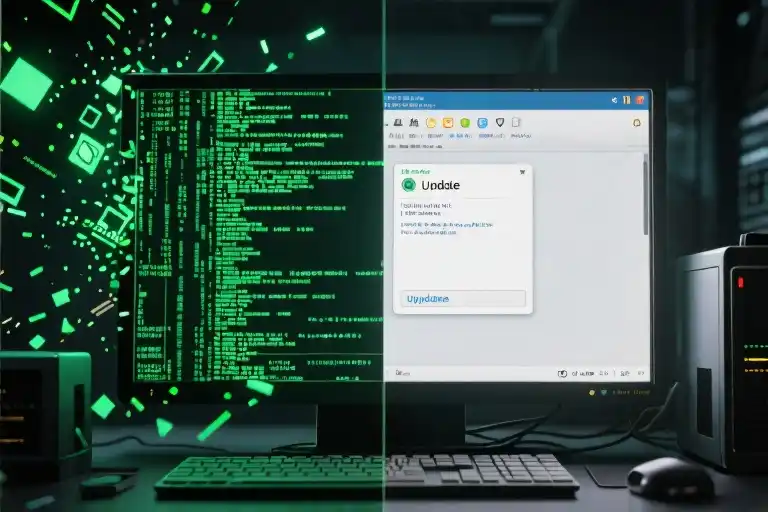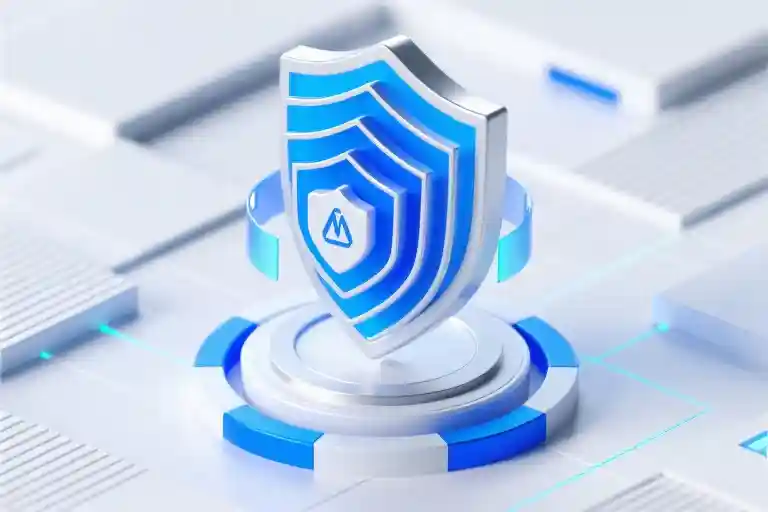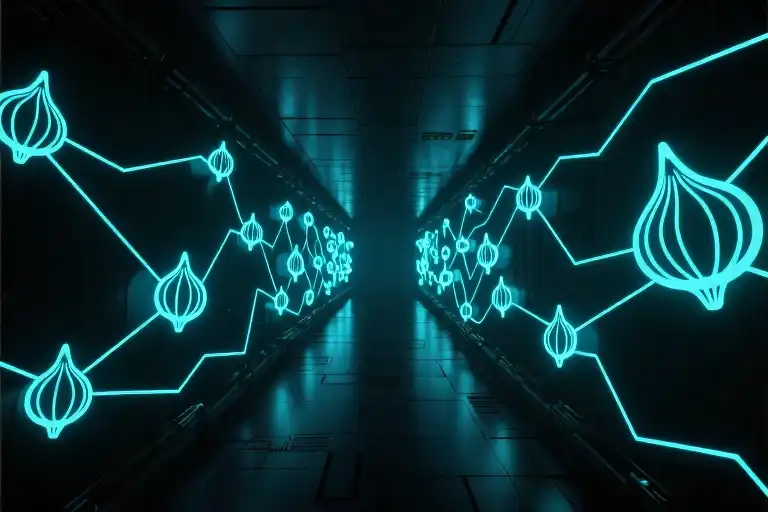You’re sipping coffee at your desk, scrolling through documentation when your childhood friend materializes over your shoulder with that conspiratorial whisper: “Bro… you know computers. Can you hack into my school’s grading system? Just tweak my math grade a little?”
The mug freezes halfway to your lips. Not this again.
With the theatrical sigh of someone who’s explained “what IT people actually do” more times than you’ve run system updates, you pivot toward your keyboard. Your fingers dance across the keys with exaggerated urgency as you launch the terminal and type the sacred incantation every Linux user knows by heart:
sudo apt update && sudo apt upgrade -yImmediately, the screen erupts in a cascade of green text scrolling faster than stock market tickers – the terminal equivalent of a Hollywood hacking montage. Your friend gasps as packages and repositories flash by, their eyes reflecting the glow of what they’re convinced is digital wizardry. “Whoa! Is that the school’s firewall?!” they breathe, leaning closer.
You don’t have the heart to tell them this cinematic display is just your package manager checking for updates to VLC media player and the latest kernel patches. The Hollywood hacking myth strikes again – where audiences expect Mr. Robot-style cyber ninjutsu, reality serves up mundane system maintenance wrapped in Hollywood’s visual tropes (green text! rapid scrolling! beeping sounds optional).
This scene plays out in tech households worldwide, where simple terminal commands get mistaken for digital lockpicks because:
- The “Hollywood Hacker” aesthetic has conditioned people to associate text-heavy interfaces with cybercrime
- Non-technical observers can’t distinguish between actual code and routine system messages
- Pop culture glorifies hacking as instantaneous when real cybersecurity work involves weeks of reconnaissance
As the terminal finishes its update ritual, your friend’s face falls. “Wait… that’s it? No password cracking? No firewall breach animations?” The disappointment is palpable. You’ve just given them a front-row seat to the most anticlimactic “hack” since someone mistook Excel macros for AI.
Welcome to the eternal struggle of technical professionals – constantly battling unrealistic expectations fueled by cinematic hacking tropes. Where movie hackers breach Pentagon systems between coffee breaks, real-world security experts spend days analyzing logs for a single vulnerability. Where film protagonists type random keys to “enhance” grainy surveillance footage, actual techs use carefully curated command-line tools with all the glamour of doing taxes.
But perhaps the greatest irony? That sudo apt update command your friend found so underwhelming is ironically closer to real cybersecurity than any Hollywood hacking scene – methodical, routine, and fundamentally about maintaining system health rather than exploiting it. The truth rarely gets a dramatic soundtrack.
Hollywood Hacking Myths: When Fiction Overshadows Reality
We’ve all seen it in movies – a hooded figure furiously typing on a keyboard with three monitors displaying cascading lines of green code. Within seconds, they declare “I’m in” as some high-security system crumbles before our eyes. This is the Hollywood hacker archetype that’s been burned into popular culture, creating expectations that rarely match reality.
The Cinematic Hacker Playbook
Blockbuster hacking scenes typically follow the same predictable (yet entertaining) formula:
- The Keyboard Symphony – Rapid, random keystrokes that somehow translate to system infiltration, often accompanied by dramatic camera zooms on fingers dancing across the keyboard
- The Visual Spectacle – Glowing 3D interfaces, progress bars that complete in seconds, and security systems represented as literal “walls” that shatter when breached
- The Instant Access – No failed attempts, no research phase, just immediate administrative privileges to any system
- The Lone Wolf Genius – A single person accomplishing what would require entire security teams in reality
Why These Scenes Stick
There’s good reason these tropes persist in entertainment:
- Dramatic necessity: Actual cybersecurity work involves hours (sometimes days) of research, testing, and waiting – not exactly cinematic material
- Visual shorthand: The flashing lights and code scrolls communicate “hacking” instantly to audiences
- Wish fulfillment: The idea of a digital superhero who can right wrongs with a few keystrokes is inherently appealing
The Reality Check
While these scenes make for great entertainment, they create several common misconceptions:
- Hacking isn’t about speed typing – Real security work involves careful planning, knowledge of systems, and often social engineering
- No system displays “Access Granted” in flashing letters – Real intrusions are often subtle and go undetected
- Green text doesn’t mean anything special – Hollywood’s signature “hacker green” is purely aesthetic; real terminal colors are customizable
This disconnect between Hollywood hacking and real cybersecurity explains why so many of us in tech field those awkward requests from friends and family. They’ve been conditioned by entertainment to believe certain things about what’s possible (and what we can do).
Next time you see one of these scenes, enjoy it for the fiction it is – then maybe explain to any non-tech friends watching with you why real security work looks very different.
Fun fact: The famous “hacking” scene in Mission: Impossible with Tom Cruise rappelling into a secure room? That’s actually more realistic than most keyboard-heavy scenes – physical access remains one of the most effective ways to breach systems.
The Reality Behind Terminal Commands
That moment when you type sudo apt update in front of non-technical friends never gets old. The screen floods with scrolling green text, terminal fonts blinking rapidly like some Hollywood hacking scene. Their breath quickens. “Are you in?!” they whisper, convinced you’re moments away from breaching the Pentagon’s firewall.
Here’s the anticlimactic truth: you’re just updating your package lists.
Why Terminal Commands Look Like “Hacking” to Non-Techies
- The Hollywood Effect
- Fast-scrolling text = instant association with movie hacking (thank you, Matrix)
- Monospace fonts and green/black color schemes mirror stereotypical “hacker UI”
- Lack of GUI creates illusion of “elite” access (when really, we’re just too lazy for graphical package managers)
- Psychological Triggers
- Mystery Bias: Humans equate incomprehensibility with sophistication
- Activity Illusion: Rapid text output suggests “things are happening” (even if it’s just repository metadata downloading)
- Hollywood Conditioning: Pop culture trained us to associate terminals with world-altering hacks
- The Sudo Paradox
That magicalsudoprefix does the heavy lifting in selling the fantasy. Non-tech observers interpret:
$ sudo [anything]as:
“Superuser do = instant admin powers = hacking!”
When actually, half the time we’re just fixing our own permission errors.
What These Commands Actually Do
Let’s demystify the usual suspects:
| Command | Hollywood Interpretation | Reality |
|---|---|---|
sudo apt update | “Bypassing firewalls” | Refreshing software repository lists |
ping 8.8.8.8 | “Tracking enemy servers” | Checking internet connectivity |
nmap localhost | “Scanning government networks” | Checking your own open ports |
cd / | “Accessing root systems” | Navigating to the base directory |
The Technician’s Dilemma
We face an awkward choice when non-tech friends witness terminal use:
- Play Along
- Add unnecessary flags (
--verboseis great for theatrics) - Pipe commands to
lolcatfor rainbow-colored “hacking” - Bonus points for randomly muttering “I’m in”
- Educate Gently
- “This is just like your phone’s App Store checking for updates”
- Compare
sudoto “using an admin password to install Zoom” - Warning: May shatter illusions permanently
- The Third Way
- Open
cmatrixin another window - Lean back and say “This might take a while”
- Enjoy your free coffee while they watch fake decryption
Why This Misunderstanding Matters
Beyond the humor, these moments reveal a serious gap in tech literacy:
- Security Risks: People overestimate what “hacking” entails, underestimating real threats like phishing
- Career Pressure: New learners get discouraged when their
lscommand doesn’t produce Hollywood results - Communication Barriers: Misaligned expectations strain tech/non-tech collaborations
Next time you see someone awestruck by terminal output, remember: you’re not just updating packages—you’re performing digital theater. And maybe, just maybe, that spark of wonder will lead them to learn what these commands actually do.
The Daily Struggles of Tech People
Every tech professional has a mental archive of absurd requests they’ve received from well-meaning but clueless friends and family. These interactions often follow a predictable pattern: wide-eyed excitement from the requester, followed by silent despair from the technician who knows exactly how this conversation will end.
The Request Hall of Fame
Some classics we’ve all encountered:
- “Can you recover my deleted WhatsApp messages from three years ago?” (Bonus points if they add “I know you can do it – they do it on CSI!”)
- “My crush posted a private story on Instagram – hack their phone so I can see it!”
- “I forgot my Facebook password from 2009 – can you get Zuckerberg to reset it for me?”
- “Make my laptop run faster by removing all viruses – I downloaded like 30 toolbars but they were all free!”
The particularly creative ones deserve special recognition:
- “My Uber driver gave me one star – can you hack their account and delete the rating?”
- “I need you to make my ex’s new relationship status disappear from my feed.”
- “Can you create an app that automatically likes all my cousin’s posts so she’ll stop complaining?”
The Art of Performative Typing
Seasoned tech professionals develop sophisticated coping mechanisms for these situations. The most common is what we call “performative typing” – the carefully choreographed dance of making ordinary computer tasks look impressively complex:
- The Dramatic Pause: Before touching the keyboard, stare intently at the screen while slowly nodding. This builds anticipation.
- Keyboard Flourish: Begin typing with exaggerated finger movements. The louder the keyboard clicks, the better.
- Command Line Theater: Open terminal and run completely unrelated but visually impressive commands:
tree /(shows a rapidly scrolling directory structure)ping google.com(the continuous output looks mission-critical)toporhtop(all those moving graphs must mean something important)
- The Fake Crisis: Suddenly stop typing, furrow your brow, and mutter “That’s strange…” under your breath. Then rapidly type nonsense for 30 seconds before sighing in relief.
- The Disappointing Reveal: “Sorry, it’s not possible” (while secretly you just checked your email).
Why These Misconceptions Persist
The root of these unrealistic expectations stems from three main sources:
- Hollywood Hacking: Movies and TV shows have trained people to believe that:
- All computer work involves frantic typing on black screens with green text
- Any task can be completed in under 30 seconds if you type fast enough
- “Hacking” is a magical skill that bypasses all security with dramatic visual effects
- The Black Box Effect: To non-technical people, our work might as well be magic. They see the output but have no framework to understand the process, leading to overestimation of our abilities.
- Vocabulary Confusion: Terms like “hacker,” “coding,” and “programming” get used interchangeably in popular media, creating confusion about what skills actually entail.
Setting Realistic Expectations
When faced with these requests, I’ve found these strategies help manage expectations:
- The Sandwich Method: Start with something positive (“I wish I could help with that!”), explain the reality (“But here’s why that’s not how it works…”), then end with an alternative (“What I can do is show you how to properly back up your photos”)
- Educational Moments: Use simple analogies (“Asking me to hack Instagram is like asking a car mechanic to build a spaceship – related fields, completely different skills”)
- Humor Deflection: “If I could really do that, I’d be on a beach right now, not answering your texts”
The Silver Lining
While these interactions can be frustrating, they represent an opportunity – each absurd request is a chance to:
- Educate: Help someone understand technology a little better
- Humanize Tech Work: Show that what we do is skilled labor, not magic
- Build Bridges: Create shared understanding between technical and non-technical people
So the next time your aunt asks you to “hack the Wi-Fi” at her favorite cafe, take a deep breath and remember – you’re not just dealing with an unrealistic request, you’re on the front lines of technological literacy.
Question for readers: What’s the most outrageous tech request you’ve ever received? Share your stories in the comments – let’s commiserate together!
From Misconceptions to Understanding
Let’s face it – the gap between Hollywood hacking and real-world cybersecurity might as well be the distance between Earth and Mars. While movies show hackers breaking into top-secret systems with flashy 3D interfaces and dramatic keyboard smashing, actual cybersecurity work often involves far less cinematic activities like reading documentation and writing scripts.
The Reality of Vulnerability Exploitation
Contrary to popular belief, hacking isn’t about magical incantations typed at superhuman speeds. Real vulnerability exploitation requires:
- Proper permissions – You can’t test systems you don’t own or have authorization to access
- Painstaking research – Understanding system architectures and potential weak points
- Methodical testing – Carefully probing for vulnerabilities without causing damage
That sudo apt update command your friend thought was hacking? It’s about as exciting as checking your mailbox for new letters. Real cybersecurity work involves similar mundane-but-necessary maintenance tasks.
Ethical Considerations in Cybersecurity
There’s an important distinction between:
- White hat hackers – Security professionals who help organizations identify vulnerabilities
- Black hat hackers – Those who exploit systems for personal gain or malicious purposes
- Grey hat hackers – Somewhere in between, often operating in legal grey areas
The cybersecurity community strongly emphasizes ethical hacking principles. After all, having technical skills comes with responsibility – just like knowing first aid doesn’t mean you should perform unnecessary surgeries.
Where to Start Learning Real Cybersecurity
For those genuinely interested in cybersecurity (not just Hollywood fantasies), here are legitimate resources:
- Kali Linux – The most popular penetration testing distribution
- Comes pre-loaded with hundreds of security tools
- Perfect for practicing in controlled environments
- TryHackMe – Gamified learning platform for cybersecurity
- Beginner-friendly rooms with guided exercises
- Great for understanding real-world attack vectors
- Hack The Box – More advanced challenges
- Active community of security professionals
- Excellent for developing practical skills
- OWASP – Open Web Application Security Project
- Fantastic resource for web application security
- Includes the famous OWASP Top 10 vulnerabilities list
Remember: Real hacking skills take time to develop. There are no instant “become a hacker” solutions, despite what movies might suggest. The journey typically starts with:
- Learning programming fundamentals
- Understanding networking concepts
- Studying operating systems internals
- Practicing in ethical, legal environments
Bridging the Knowledge Gap
The next time someone asks you to “hack” something for them, consider it an opportunity for education rather than frustration. You might explain:
- Why their request isn’t technically feasible
- The legal implications of unauthorized access
- How real security professionals approach problems
Who knows? You might just inspire someone to pursue legitimate cybersecurity training rather than chasing Hollywood fantasies. And if nothing else, you’ll save yourself from having to theatrically type sudo apt update ever again.
The Big Letdown: When Hollywood Hacking Meets Reality
Your friend’s eyes are still glued to the terminal screen as the last lines of sudo apt update finish scrolling. The moment of truth arrives.
“Wait… that’s it?” they ask, confusion creeping into their voice. “I thought you were going to, like, hack into the mainframe or something. Where’s the 3D firewall visualization? Where are the access codes?”
You lean back in your chair, resisting the urge to facepalm. “Welcome to real-world computing,” you say. “That was just my system checking for software updates.”
The Five Stages of Tech Disappointment
This scene plays out in variations across tech households worldwide. After analyzing hundreds of similar encounters (okay, maybe just recalling my own awkward moments), I’ve identified the universal reaction pattern:
- Awe (“Whoa! You’re typing so fast!”)
- Confusion (“Why does it say ‘404 Not Found’? Is that good?”)
- Suspicion (“Are you messing with me?”)
- Disappointment (“This looks nothing like Mr. Robot!”)
- Denial (“No, seriously, can’t you just try hacking it?”)
Why Pop Culture Got It All Wrong
The entertainment industry has conditioned us to expect hacking to resemble a high-speed video game:
- The Magic Keyboard Trope: Where furious typing somehow bypasses all security layers
- The Instant Access Myth: Where complex systems crumble in 30 seconds flat
- The Visual Spectacle: Where data manifests as glowing 3D objects in space
In reality, most cybersecurity work involves:
- Reading lengthy documentation
- Writing and testing small code snippets
- Waiting for systems to respond
- Drinking copious amounts of coffee
Turning Disappointment Into Opportunity
When faced with the inevitable “That’s it?” moment, I’ve found these responses work wonders:
- The Reality Check:
“Actual hacking looks more like reading terms of service than playing a video game.” - The Pop Culture Bridge:
“You know how cooking shows edit out all the prep work? Hollywood does that with hacking too.” - The Gateway Drug Approach:
“Want to see something actually cool? Let me show you how password cracking really works…”
Your Turn: Share the Struggle
We’ve all been there. That moment when someone’s Hollywood-fueled hacking fantasy crashes into the mundane reality of terminal commands.
What’s the most entertaining (or cringe-worthy) tech misunderstanding you’ve encountered? Drop your stories in the comments – let’s commiserate and laugh together.
For those genuinely interested in learning real cybersecurity skills (not the Hollywood version), check out these beginner-friendly resources:
Remember: Real hacking skills take time to develop, but at least you’ll never have to fake typing dramatically again.





